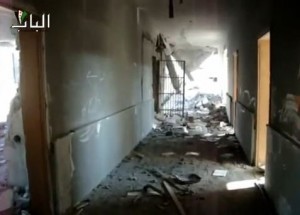The Educational System in Syria: A Tragic Reality and an Obscure Future

The education system in Syria is in a terrible state. Military engagements, bombardments and airstrikes have displaced millions of Syrians, preventing tens, if not hundreds of thousands of students from attending school. The Syrian government has turned some schools into detention centres and barracks. School buildings have been destroyed in the fighting and still other schools are being used to house refugees.
According to a United Nations Children’s Fund-UNICEF statement in May, around 20 percent of Syria’s schools have either suffered direct war damage or are being used to shelter displaced people. The UN agency says the fighting in Syria has damaged and destroyed 2,960 schools out of a total of over 22,000 schools in the country. At least 1,400 schools are being used as shelters, and the conflict has killed 222 education staff. An UNICEF report published in March points out that many children, especially those in cities witnessing intense conflict, have missed out on two years of schooling.

Contested and opposition-controlled areas have been hit the hardest, with air strikes and the displacement of large numbers of local people continuing to prevent students from attending school. Moreover, an increasing number of reports have documented the use of curricula that differ from the one taught in the Baathist-run Syrian education system. Hassan Abbas, a professor at the French Institute for the Near East in Damascus and at the Sorbonne University, published an article called “The Syrian School Now,” in which he says that “some of the Kurdish-majority areas opened schools that are teaching children a comprehensive curriculum adopted from schools in Kurdistan, Iraq, and in [the] Kurdish [language].”
Some schools for Syrian refugees in Turkey have adopted a new, opposition issued textbook with changes from the old Syrian government-approved curriculum. Other reports say Syrian refugee students in Turkey are learning Arabic, Turkish, math and religious studies.
George Talmas, who used to work as a teacher before the outbreak of the revolution and later became active in teaching displaced students, says education suffers from many problems in the areas under the control of the opposition in the Damascus countryside. Talmas has noticed “the parents’ disinterest, society’s disregard for the importance of education, and the lack of curricula.”
Most importantly, he says, there is a “lack of the required funding for the educational process to continue. Donations go to providing weapons, medicine or food while education gets nothing.”
On the other hand, Bader Jamous, manager of the education office in the opposition’s Syrian National Council and member of the Syrian National Coalition, emphasizes that the Coalition is working on “securing schools and curricula for those students who missed out on more than a year and half of schooling in some areas.”
Jamous adds that the Coalition is also working on “a plan to study the curricula, form and supervise exam committees, ratify certificates, and communicate with countries that would give admissions to our students to continue their university education.”
Jamous denies using new curricula in the areas under the control of the opposition. He clarifies that the same curricula are being taught “excluding nationalist education subjects and some chapters in history books that have been implanted by the regime to improve its image and polish that of the ‘immortal leader,’ [Hafez al-Assad], as they used to call him.”
Jamous’s words, however, contradict the testimony of an activist in the Damascus countryside who goes by the pseudonym Hala al-Ali. Ali says that a school in the town of Misraba, for which she provided needed equipment, has mandated that “more than 50% of its curricula be Islamic,” in addition to segregating males from females and requiring students to adhere to prayer times. The school even has an Islamic name, the “Fistat Al-Moslemeen,” or the “Muslims’ Military Camp.”
This bad condition of the educational sector in Syria dates back to before the March 2011 uprising against Assad’s government. According to Masah al-Mofti, former manager of the Teaching and Educational Department in the Syrian Trust for Development, an organization that is close to the government, education suffers from many problems. These problems stem from the government not regarding the sector as an essential and strategic one as was demonstrated when education was listed as a secondary priority in the Syrian government’s reform plan and the country’s 10th national five-year plan.
Mofti describes the education sector as part of a “Baathist system, based on rote learning instead of an empowering one.” Moreover, Mofti wonders, “how can a student become the intended perfect citizen when, [from the beginning], she does not have freedom of expression and [is not taught] to think outside the box?”
Mofti considers that one of the primary problems of the Syrian education system is the absence of the concept of leadership.
“School principals are appointed not according to their capacities and expertise, but according to political and nepotistic measures that the Ministry of Education itself has no jurisdiction over,” says Mofti.
Furthermore, she says there is no space given for educational directors and teaching staff to participate in making decisions.
Massa al-Mofti also warns against making arbitrary changes to the Syrian educational curricula and replacing the current Baathist education system with another system that is just as fundamentalist and rigid.
Mofti believes that the solution to creating better education in Syria and for Syrians will come through adopting “subjects that teach citizenship and philosophy in their humanitarian, non-exclusionary sense, [in order] to teach students to understand and recognize their human role and duty to respect their human fellows regardless of their ethnicity or religion.”
***
